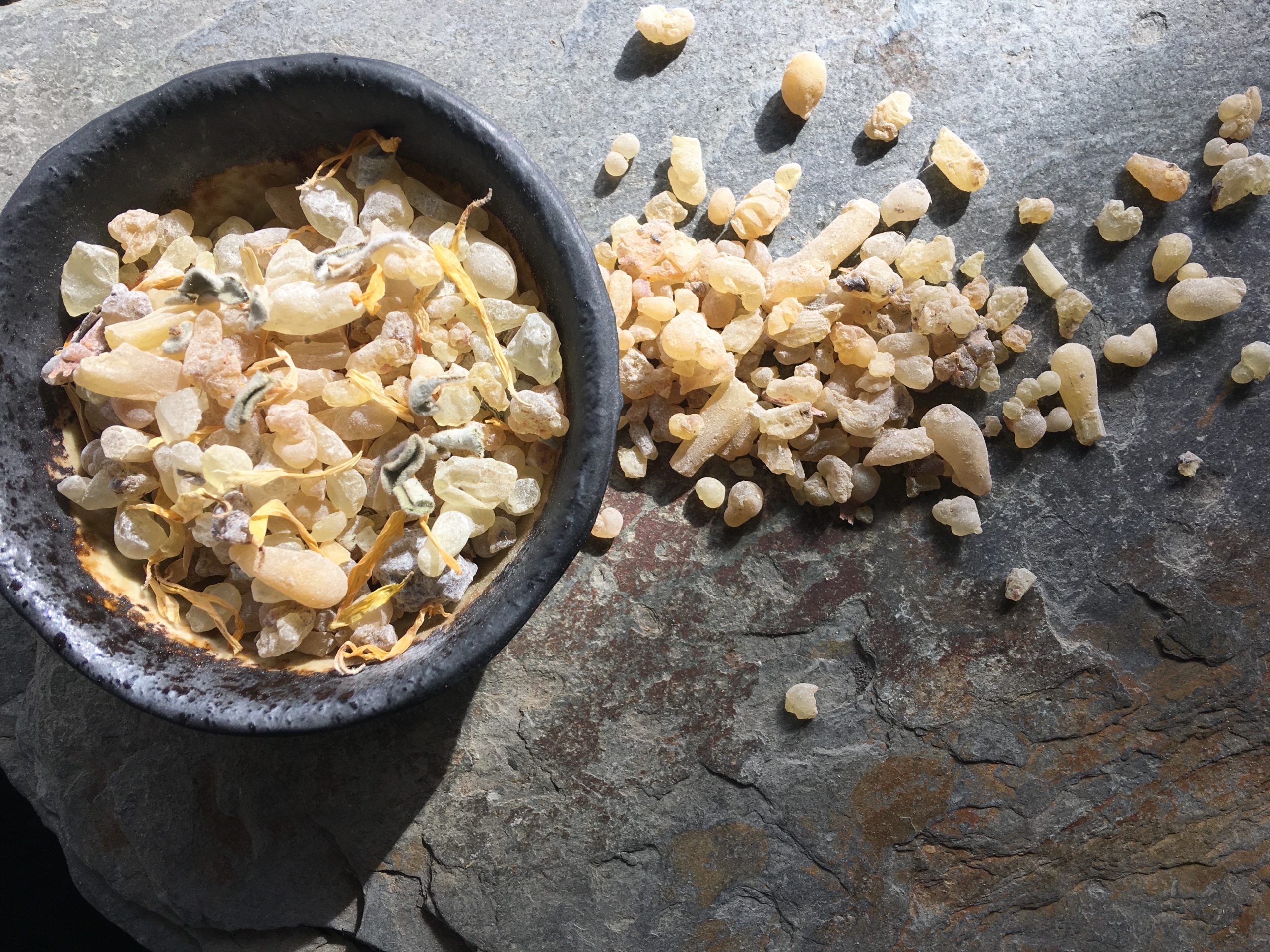
“Who is this that cometh out of the wilderness like pillars of smoke, perfumed with myrrh and frankincense, with all powders of the merchant?” Song of Songs 3:6
Of all the resins used for incense burning, frankincense is probably the most well-known. The word ‘frankincense’ is derived from the old french “franc encens” meaning high quality incense, although older names include Olibanum (from the Greek ‘libanos’, which derives from the Hebrew ‘levona’ or ‘lavan’ meaning ‘white’) and Luban; an Urdu word from the Arabic ‘al luban’ meaning ‘the milk’ in reference to the milky colour of the sap. Recorded use in worship and medicine stretches back five thousand years to the Egyptian papyrus scripts, but it was most likely used in times of antiquity well before then. Aligned with the sun, the element of fire, and the astrological signs of Sagittarius, Libra and Aries, Frankincense has been used across cultures for millennia for its antiseptic, anti-inflammatory and analgesic properties when applied internally, topically or inhaled as smoke, as well as for its energetic healing. It was traded by the Babylonians and Assyrians, was a staple of traditional Chinese medicine since at least 500 BC, appears in ancient Indian Ayurvedic texts, is mentioned extensively in the Old Testament, was used throughout ancient Egypt in a vast range of applications, and was adopted by the Christian and Catholic church for purification and worship.
Part of the Boswellia genus, there are many types of frankincense, including Boswellia Carterii, Boswellia Sacra and Boswellia Frereana. They are part of the Burseraceae family that also includes myrrh and Palo Santo! You might recognise the similar fresh citrus/pine scent in each..
Originating from scrubby, tough trees that grow wild, straight out of the sandy soil and often straight out of the rock, in parts of Northern Africa and the Arabian Peninsula, these hardy plants cannot be grown commercially and must be sought out in the mountainous regions of Somalia, Yemen and Oman. Harvesting frankincense resin takes around five months; harvesters travel long distances, leaving their communities behind and taking shelter in caves along the way as they gather the resin from remote locations. The sticky, milky resin oozes out of cuts in the tree (made in a practice known as ‘tapping’ – cuts or incisions carefully made by harvesters that do not cause lasting damage to the plant) and the sap dries to hard ‘tears’ in the sun. Once the frankincense tears are harvested, they are cleaned, separated, and graded. Trees are tapped twice a year but every five-six years are left untapped, so as not to disrupt the balance of sap production within the tree.
The ancient Greek philosopher Herodotus wrote of harvesters burning storax resin at the base of the trees while collecting frankincense, in order to guard against winged serpents that protect them. Although some sources believe this story was a ploy devised by harvesters to ward off their competitors!
“[The Arabians] gather frankincense by burning that storax which Phoenicians carry to Hellas; they burn this and so get the frankincense; for the spice-bearing trees are guarded by small winged snakes of varied colour, many around each tree; these are the snakes that attack Egypt. Nothing except the smoke of storax will drive them away from the trees.”
‘Herodotus of Halicarnassus’ (c.440 BC) III.107.2
According to ‘The Egyptian Book of the Dead’, the resin tears were viewed as “the sweat of the gods, fallen to earth.” Across cultures, all that have used this precious commodity seem to have recognised a clear connection between the resin and the divine. Frankincense was a large part of Egyptian, Greek and Roman burial rites – burned to enable the departed soul to journey on the smoke upwards to heaven, and to mask the smell of decay. The Roman emperor, Nero, burned a whole year’s harvest of frankincense (thereby completely disrupting the following years trade!) at the funeral of his favourite mistress! The ancient Egyptians also burned frankincense at sunrise to worship the sun god Ra, and they used the ash from burned frankincense to make a black paste used as eyeliner..
Although the Christian church outlawed the use of frankincense smoke as a pagan tradition, denominations such as the Catholic church later adopted it: wafting censers of smouldering resin as a way to fumigate: eliminating airborne toxins, and covering the stench of unwashed worshipers. Frankincense smoke has even been proven to improve the acoustic properties of a space – perhaps this is another reason why it was used so frequently in sacred settings; combined with chanting and music. In Oman, it is customary to smoke one’s clothes with frankincense using a frame specially made for the purpose.
Throughout antiquity frankincense was used as a remedy to treat a variety of ailments including nausea, indigestion, chest coughs, hypertension, recovery post-childbirth, ulcers and fever. Many countries across the world burned frankincense and other resins to ward off mosquitos and other insects; thereby preventing the spread of malaria and other insect-borne diseases.
Researchers from the Johns Hopkins University and the Hebrew University in Jerusalem discovered that smelling burning frankincense activates the protein TRPV3, producing lower anxiety levels and anti-depressive-like behaviour. Other research is now underway into the use of the resin as a possible treatment for some cancers, ulcerative colitis, Crohn’s disease and asthma among other conditions. It seems modern medicine is slowly providing evidence to back up what the ancients knew all those thousands of years ago!
SOURCES:
http://www.history.com/news/a-wise-mans-cure-frankincense-and-myrrh
https://www.mei.edu/sqcc/frankincense
https://en.wikipedia.org/wiki/Frankincense
https://www.sciencedaily.com/releases/2008/05/080520110415.htm

